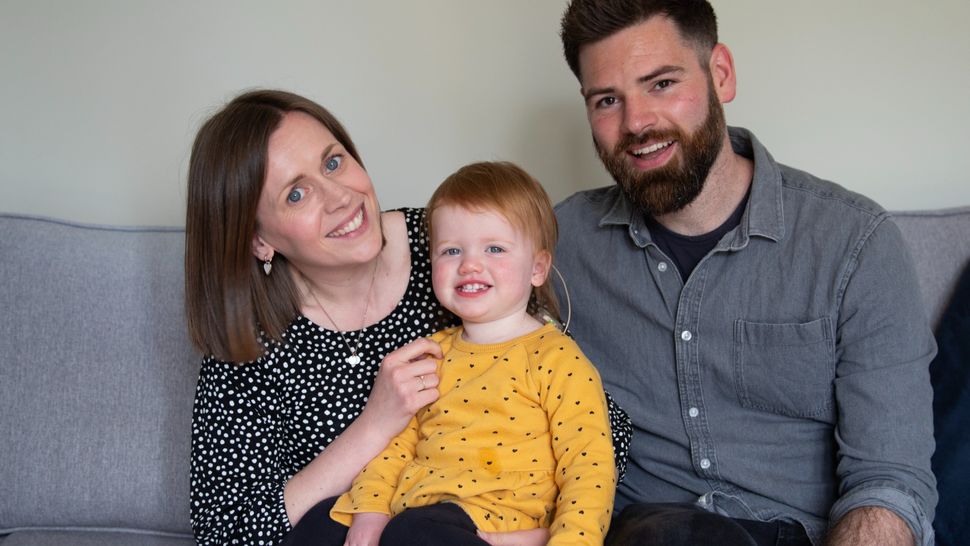Science
Related: About this forumDeaf baby can hear after 'mind-blowing' gene therapy treatment
By Emily Cooke published 5 hours ago
Seven months after her treatment, the baby girl can now respond to her parents' voices without the aid of a cochlear implant.

Image of a toddler girl sat with her mother on her left and her father on her right. They are all smiling at the camera. The mother is wearing a black-and-white polka dot top, the toddler is wearing a bright yellow top and the father is wearing a grey shirt.
Opal Sandy from the U.K. was treated as part of an ongoing global trial investigating a new gene therapy for a rare type of congenital hearing loss. She's pictured in the image above with her parents. (Image credit: Cambridge University Hospitals NHS Trust)
A toddler who was born completely deaf due to a rare genetic condition can now hear unaided thanks to a pioneering gene therapy.
Opal Sandy, who is now an 18-month-old girl from the U.K., is the youngest child in the world to receive this type of gene therapy, which uses a harmless, modified virus to correct genetic mutations in the body's cells. In this case, the therapy replaced a mutant gene associated with deafness with a working copy of that gene, according to a statement released May 9 by Cambridge University Hospitals.
Very similar gene therapies are being tested in other trials and have shown early success in treating slightly older children with the same type of hearing loss as Opal.
Known as auditory neuropathy, this type of hearing loss arises when the ears can detect sound but can't relay that information to the brain. The condition is caused by mutations in a gene called OTOF that normally makes otoferlin, a protein needed for the inner ear to talk to neurons that are linked to the brain. The condition accounts for between 1% and 8% of cases of congenital hearing loss that occurs in the absence of other symptoms.
More:
https://www.livescience.com/health/genetics/deaf-baby-can-hear-after-mind-blowing-gene-therapy-treatment
SWBTATTReg
(24,085 posts)that's what caused my hearing loss, nerve damage. I know that they can repair damaged nerves (my sister had), but one day....
How exciting and thank you for sharing.
OAITW r.2.0
(28,361 posts)Srkdqltr
(7,659 posts)Amazing.
Judi Lynn
(162,374 posts)Opal was diagnosed at 3 weeks old. When she was 11 months old she became the first patient treated in a global trial of the new gene therapy. She was given the new treatment via an injection into her right ear. The virus injected during the procedure — known as an adeno-associated virus — delivers a working copy of OTOF to cells in the ear to replace the mutated version. Afterwards, the virus is naturally eliminated from the body.
Doctors also installed a cochlear implant in Opal's left ear; these devices help users hear some sound by relaying signals to the brain that their ear cells can't.
Within four weeks of the gene therapy, Opal could respond to sounds even when her cochlear implant was switched off, her doctors reported. Twenty-four weeks out from treatment, her treated ear could pick up soft sounds, such as whispering, at "close to normal" hearing levels. Now, at 18 months old, Sandy can respond to her parents' voices without her implant activated and say words such as "dada" and "bye-bye."
"When Opal could first hear us clapping unaided it was mind-blowing — we were so happy when the clinical team confirmed at 24 weeks that her hearing was also picking up softer sounds and speech," Opal's mother Jo said in the statement. Her father, James, noted that Opal can't wear her implant in certain contexts, such as in the bath, so the therapy is already making a difference in their day-to-day lives.
The ongoing trial that Opal is part of is enrolling patients in the U.S., the U.K. and Spain. In this stage of the research, patients receive a low dose of the therapy in one ear. Future trials will test the therapy at higher doses in one ear and then in both ears. Patients will be followed up for five years to assess long-term outcomes.
Srkdqltr
(7,659 posts)NNadir
(34,659 posts)The problem with this technology is that it's often "one and done." This means that all the costs of development must be paid with a single dose. I as it takes about two billion dollars to bring a drug to market; well do the math on rare diseases requiring only one dose or just a few doses.
This may sound terrible, but I like to be paid for what I do.
colorado_ufo
(5,926 posts)Or do you need to wait until it goes to market?